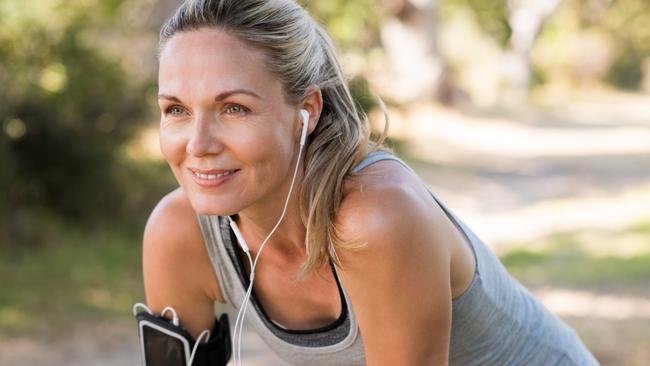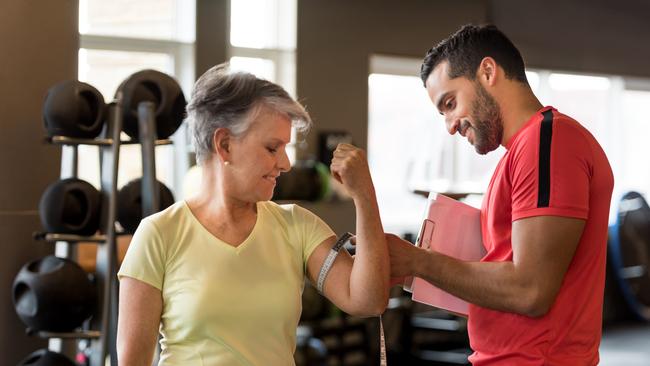How to get the body of someone 20 years younger
The researcher behind a new study on physiological ageing explains how his short, sharp fitness regimen can be used to turn back time | The workout

Peter Herbert has just returned from a full afternoon’s surfing on the Carmarthenshire coast. Tomorrow he says he will be back on his racing bike in training for the 500m sprint time trial event he is due to compete in at the British Masters National Track cycling championships in September.
His athletic prowess is impressive, all the more so when you consider that Herbert is 76. An associate professor in the Centre for Health and Ageing at the University of Wales Trinity Saint David, he is the living embodiment of his research, which has shown that exercise cannot only slow the rate of biological ageing but reverse it.
In a paper published in Experimental Gerontology this month, he reveals how a man in his late sixties can cut his biological age by up to 20 years through exercise alone.
Over the past decade, all of Herbert’s many studies have focused on finding out which workouts, if any, will help to stem the gradual decline in strength, power and aerobic capacity that occur with advancing years.
On average a man’s maximum attainable heart rate declines by about one beat a minute each year after the age of 30. About 90g of muscle is lost each year from the age of 40, meaning that a man in his seventies who does no exercise typically has a third less muscle than a 25-year-old.
And aerobic capacity, or the maximal amount of oxygen your body can consume during hard exercise, as measured with a VO2 Max test, tails off with age. “In non-athletes – ie most people – there is typically a 16 per cent decrease in aerobic capacity by your fifties, but a dramatic 26 per cent drop from your seventies onwards,” Herbert says. “Since lower levels of cardiorespiratory fitness are strongly associated with an increased risk of cardiovascular disease and all-cause mortality, any way in which we can slow this decline would help to offset some of the effects of ageing.”

For his first paper, published in 2015, he recruited 19 masters athletes, aged 55-74, lifelong super-exercisers who were actively competitive in cycling, rowing, squash and triathlon events, and persuaded them to reduce their regular training load from a minimum of three hard sessions a week to a high-intensity workout every five days, which he called Fit HIIT. It comprised six 30-second sprints performed at 90 per cent of their maximum effort on an indoor bike, each burst followed by three minutes of recovery.
In between all they did was gentle aerobic activity such as walking or jogging for no more than half an hour a day.
“They adopted the approach reluctantly, many believing that they would see a steep decline in fitness levels,” Herbert says. “But it’s not easy and by the fifth and sixth sprint your legs will turn to jelly and it will start to feel uncomfortable, however fit you are, because the idea is to push almost to the limit of your physical capacity.”
Another group of 25 participants who had been sedentary for up to 30 years were asked to follow a six-week preliminary conditioning program of light to moderate activity just to bring them up to the recommended National Health Service guidelines of 30 minutes of moderate activity a day or 150 minutes a week.
After that they moved on to the same Fit HIIT approach performed at their own level of effort once every five days for the next six weeks. Those results, reported in Age, the peer-reviewed journal of the American Ageing Association, revealed significant improvements in leg power, aerobic capacity and body fat in both groups across the board.
Even those who were super-fit to start with benefited from the abbreviated high-intensity workouts with enhancements to their age-related physiological profile. However, Herbert wanted to know if the effects were longer lasting and if the tide of time could be further deferred. So for his latest paper he reassessed the same men to find out how they fared four years down the line, aged 59-78, having been left to their own devices in the interim.
This time results clearly indicated that brief high-intensity exercise can help to reverse the effects of ageing, at least in terms of cardiovascular health.
There was no age-related decline among the lifetime super-exercisers, who had impressively higher aerobic fitness at the start of the trial and had continued doing the Fit HIIT on average once every five to ten days on top of other moderate exercise even after the original study had finished.

“In our first set of results these men had an average age of 64 and a VO2 max score of 38ml/kg that was excellent for their age and matched the score we would expect in a non-athletic man aged 45 to 49 years old,” Herbert says. “Their scores rose slightly to 44ml/kg after the six-week Fit HIIT, but four years later there was no drop. Now with an average age of 68, they had the cardiovascular function of someone 20 years younger.”
Ah, you might be thinking, but they are seriously athletic and hardly representative of your average mid-to-late-life male. Yet benefits were evident across the board, with perhaps the most eyebrow-raising outcome being among the men who were sedentary before they took part in the trial and returned to more or less the same levels of inactivity after it.
According to Dr Lawrence Hayes, a lecturer in exercise physiology at the University of the West of Scotland and one of Herbert’s co-authors, the six-week preconditioning program followed by the six weeks of Fit HIIT had improved their aerobic capacity by so much during those 12 weeks that it took four years for levels to drop back down to where they were when they were recruited.
“In other words, where we would have expected a downturn in aerobic capacity by as much as 26 per cent as they got older, in that respect they had not physiologically aged at all in those four years,” Hayes says. “The exercise had an anti-ageing effect.”
Of course total inactivity will eventually take its toll. These men had a lower than ideal aerobic capacity to start with and the longer they laid off exercise, the steeper the decline over the next few years. Yet the message isn’t that they need to be hardcore about it.
“For older athletes we recommend doing the Fit HIIT workout once every five to ten days, but for the average person who doesn’t do much else in terms of activity, it need only be once every three weeks,” Herbert says. “Our research has shown that the effects of it are considerable and that, accompanied by plenty of moderate activity the rest of the time, it will keep you aerobically younger as long as the fast, hard bursts are in your program somewhere.”

Given this undemanding volume of hardcore workouts, it might be that even the most reluctant exercisers could be persuaded also to squeeze in an abbreviated strength session. For another study awaiting publication, Herbert and colleagues found that a single 20-minute weekly targeted weight-training session was more effective in building functional strength gains in older people than a 40-minute workout with weights.
“We found that a 20-minute routine involving just three “multi-joint’‘ exercises – the leg press, the lateral pull-down and the bench press – was sufficient to strengthen the whole body in half the time of a workout that used single-joint exercises such as bicep curl and leg curl,” he says.
“Those three multi-joint moves will cover everything as they involve pulling and pushing the upper and lower body, engaging triceps, biceps, back and chest muscles, hamstrings, quadriceps and glutes.” Strength gains between the two groups were similar, but the multi-joint exercise group had greater improvements in functional movement such as sitting, standing, balancing and squatting, all of which tend to deteriorate with age.
In 2022 Herbert plans another reunion study in which he will compare the fitness statistics of his cohort a full decade after they signed up to take part in his research. He has high hopes for their age-defying accomplishments. “By then some of the men will be octogenarians,” he says. “But only by number – I expect their biological age to be at least a couple of decades younger than that.”
The anti-ageing workout
Preconditioning program
This is essential if you have spent the past year doing very little exercise.
Weeks 1-4
Build up to 20 minutes a day of walking at a fairly brisk pace.
Week 5-6
On alternate days do:
Day 1 (am) – three minutes of steady walking or cycling, four minutes of faster walking, three minutes of steady walking; (pm) – 10 minutes of steady activity.
Day 2 – 20 minutes of steady walking.
Fit HIIT
1: Perform either six 30-second sprints on a bike (with three minutes of very gentle cycling recovery between each burst) or six 20-second sprints of uphill running or on a rowing machine (three minutes of gentle recovery).
2: If you wear a heart rate monitor you should push to 90 per cent of your maximum heart rate. If not, work hard enough that you are puffing and unable to speak during the “efforts”. “It’s not supposed to feel easy and it won’t be particularly enjoyable,” Herbert says. “But you will reap the long-term benefits.”
3: For the first six weeks do this every five days to allow full recovery between each interval session. After that, even if you are very fit, don’t repeat the Fit HIIT session more often than every five days. For non-athletes in their forties or fifties every 10-15 days is sufficient. For those aged 60-plus, once every three weeks is enough.
4: On other days stay moderately active. “Move as much as you can,” Herbert says. “Run, swim cycle, surf, do yoga or whatever you enjoy doing with moderate intensity.”
Strength gains
Do these three exercises with weights that allow you to perform 10 repetitions of an exercise before needing a break. You will need to do a combination of them for a total of 20 minutes a week:
Lateral pull-down: Sit in front of the pull-down machine at the gym with feet flat on the floor. Push chest up and out and extend arms to grab the handles of the machine, taking a wide grip. Inhale, keep shoulders down and pull down the bar in front of you using your elbows until you feel your shoulder blades are together and you can squeeze the lateral muscles in your back. Slowly raise the bar back up and repeat.
Bench chest press: You can perform this with a barbell or on a machine. To do it with free weights, lie flat on your back on a bench and grip the bar with hands just wider than shoulder-width apart. Bring the bar slowly down to your chest as you breathe in. As you breathe out, grip the bar hard and push up, aiming for a steady controlled movement. Repeat.
Leg press: Place feet shoulder-width apart on the platform. Engage your core muscles and exhale as you drive away with your feet. Be sure to push with both feet simultaneously from the toes to the heels and don’t completely lock the knees at full extension. Inhale and slowly return to your original position, bringing your knees back down toward your bottom at a 90-degree angle. Repeat.
Note: if you have underlying health conditions or have not exercised in a while, please seek medical approval before attempting these workouts.
The Times







To join the conversation, please log in. Don't have an account? Register
Join the conversation, you are commenting as Logout